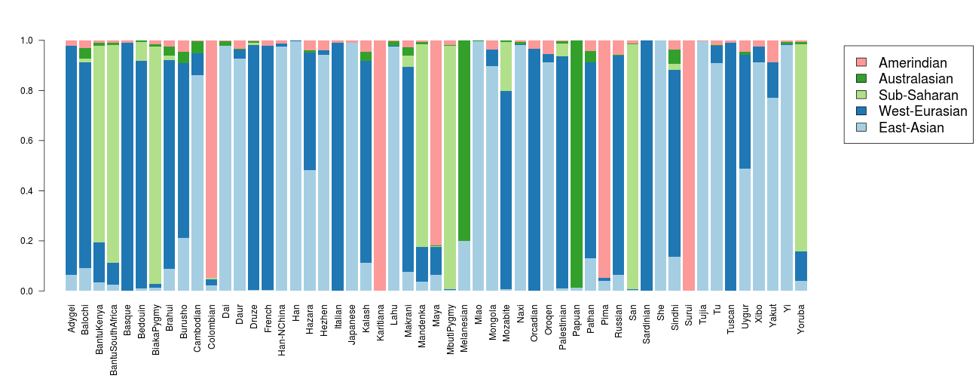American Indians, Neanderthals and Denisovans: PCA and ADMIXTURE
Dienekes continued his search for “archaic admixture” in world populations. This time he blended ADMIXTURE and PCA approaches to plot 5 composite populations detected by ADMIXTURE in the Harvard HGDP set. American Indians are back in. The ADMIXTURE plot replicates the finding of a pervasive Amerindian component in Eurasia and shows that it extends all the way to African Yoruba, a population that’s considered representative of a back-to-Africa migration in studies that don’t use American Indian data. (Some populations such as Miao or Mozabites apparently lost the Amerindian component through drift.)
The associated PCA is very similar to the one that lacked American Indians. Neanderthals are bottom left, Denisovans are top left.
What stands out it the degree of variability of the American Indian sample (dark green dots). They are extended up and down, left and right and nearly circumscribe the whole West Eurasian/East Asian cluster. Neither East Asian, nor the West Eurasian samples show the same degree of variability. Looking vertically, the dark green dots stretch from the East Asian side of the East Asian/West Eurasian/Amerindian cluster to the West Eurasian side. And again on the West Eurasian side the American Indian dark green dot is among the furthest removed toward the Neanderthal direction. The greater proximity of West Eurasians to the Neanderthal pole is very natural, but the presence of American Indians in those areas of the PCA plot is a surprise. Similarly, one dark green dot is shifted toward the Australaisan cluster, which is consistent with the presence of Denisovan “admixture” in South America. The overall impression is consistent with the conclusion from craniology, namely that the formation of the American Indian physical type preceded the split between Mongoloids and Caucasoids in Eurasia.



